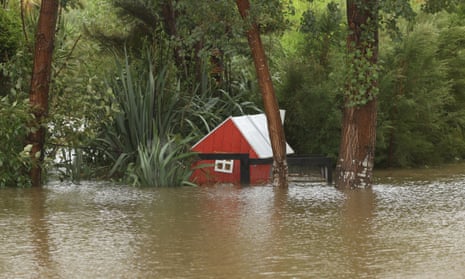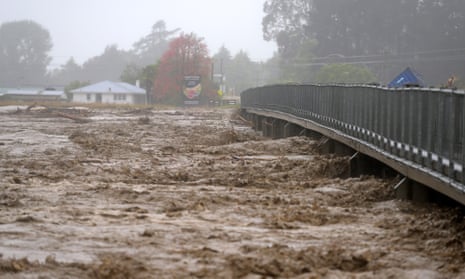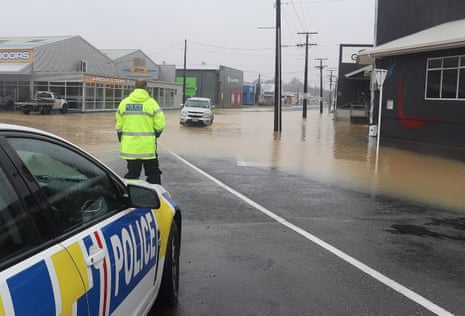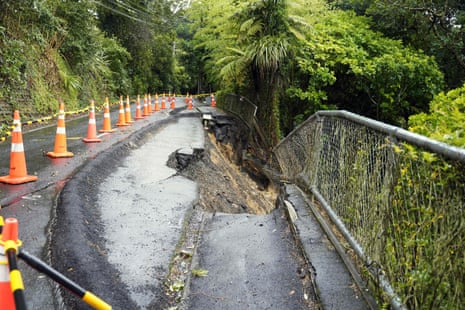Key events Show key events only Please turn on JavaScript to use this feature
Power might not be restored for weeks, grid operator says
Charlotte Graham-McLay
New Zealand’s national power grid operator has declared a “grid emergency” and warned that power might not be restored to some for “for days to weeks, rather than hours”.
The widespread power cuts in Hawkes Bay and Bay of Plenty happened after a substation flooded during severe rain from Cyclone Gabrielle.
“Due to the current situation, we are not able to obtain communications from our substation, but it is likely the Redclyffe substation is under water,” the company said in a news release.
Nothing would be done to restore power until Transpower is sure the situation is safe for workers on the ground, the statement said.
High winds prevent rescues of people trapped in homes and vehicles
Multiple people are still trapped on roofs, in vehicles and in homes by flood waters, with helicopters unable to reach them due to high winds.
According to Fire and Emergency NZ, multiple people on state highway in the Hawkes Bay are trapped in vehicles and in houses, and people are trapped awaiting rescue in Puketapu. There are also many houses flooded in Eskdale and Whirinaki which can’t be reached by road as the bridge access is washed out.
“Helicopters aren’t currently able to rescue people trapped on roofs due to the high winds. This is an ongoing situation and we are monitoring it closely,” they said in a statement.

Hawkes Bay residents told: 'Go immediately to the nearest hill'
New emergency evacuations launching as flood waters continue to rise. In the Hawkes Bay, civil defence told residents “evacuate immediately… Go immediately to the nearest hill… Take grab bags and animals”.
That order currently applies to residents in Waiohiki, Omahu, Taradale, Jervoistown and Meeanee.
“Flood protection systems on the Tūtaekurī River are failing to contain flood waters,” they said.

'This is climate change,' says minister of cyclone's devastation
Climate change minister James Shaw on the cyclone’s effects: “This is climate change.”
For only the third time in our history a National State of Emergency has been declared. Please follow official advice and stay safe.
This is climate change. The impacts will get worse unless we act NOW to cut emissions quickly and adapt communities for the effects already here.
Widespread flooding in Napier
Some images here of the very extensive flooding in Napier, which has washed out bridges and inundated homes. Social media images and video have emerged from that area of people sheltering on roofs and houses being washed away.


Hipkins says New Zealand has to re-evaluate where it builds communities
Hipkins says the recovery is likely to be lengthy, with some people displaced for a long time.
We know that this won’t be an overnight recovery. It’s going to take a while some people will be displaced from their homes for an extended period of time,” he says.
Our focus right now is on the immediate response – it’s on making sure that people have a roof over their head, that they have a meal, that their families are well-cared for. That’s the that’s the immediate focus. The recovery effort is something that we will absolutely be placing front and centre of the government’s program over the next few weeks and months.
He’s also indicated that this extreme weather event – and others like it – have to change how and where New Zealand builds its communities.
We need to look at the sustainability of some of the places where we have built previously … We’ve got a long history of poor past decisions in New Zealand that we’re confronting right now.

Hipkins says Cyclone Gabrielle is “an extreme weather event … probably the biggest that we have seen in recent times comes, and it comes hot on the heels of other extreme weather events.” A number of the regions worst-effected were still in the process of cleanup from devastating flooding a fortnight ago when the storm hit.
He says it is still too early to provide any figures on the number of people displaced or injured.
PM warns of ‘extensive damage done across the country’
The prime minister, Chris Hipkins, is giving an update now on the emergency response. He says the government is still trying to track the extent of the damage.
“It will take us a while to get a handle on exactly what’s happened,” he says. “A lot of families displaced, a lot of homes without power, extensive damage done across the country.”
Minister declares state of emergency, urges those at risk to evacuate
Kieran McAnulty, New Zealand’s minister for emergency management, says the worst of Gabrielle may be over, but more rain and high winds are expected.
“[While] we are through the worst of the storm itself, we are all facing extensive flooding slips, damaged roads and infrastructure,” he said on Tuesday morning.
“Our message to everyone affected is safety first: look after each other, your family and your neighbours.”

If people were facing dangerous conditions, he urged them to proactively evacuate: “If you are worried about your safety, particularly because of the threat of flooding or slips, then don’t wait for emergency services to contact you, leave and seek safety.”
The national state of emergency – a designation that has only been used in New Zealand twice before – is a “significant legal instrument”, McAnulty said, allowing the government to send more resources to affected regions with “a nationally coordinated approach”.
Summary and welcome
Hello and welcome to our live coverage of Cyclone Gabrielle. I’m Tess McClure, I’m based in Auckland, and I will be keeping you up to date on developments as they come in. Here is what we know so far:
The government has declared a national state of emergency, only the third time in New Zealand history it has done so. The declaration was made at 8.43am and means the response will now be coordinated by the central government rather than local authorities.
Damage and flooding is extensive, and the worst-effected areas appear to be on the east coast and far north of the North Island. Bridges and roads have been washed away, houses submerged and landslides have destroyed homes with some people sheltering on roofs and awaiting rescue.
Some communities have been cut off entirely, with power, road access and mobile networks down. Officials say Tairāwhiti/Gisborne is currently only reachable by satellite phones.
Conditions are impeding some rescue and evacuation efforts, with roads cut off, and the weather affecting helicopter flights. Two firefighters were trapped in a landslide in Muriwai while checking a home – one is in a critical condition and the other still missing after search was suspended due to the instability of the land.
There are more than 120,000 homes are without power across the North Island. The power outages are also affecting mobile networks in some regions.
The government has urged people at risk to proactively evacuate: “If you are worried about your safety, particularly because of the threat of flooding or slips, then don’t wait for emergency services to contact you; leave and seek safety.” Some communities are covered by mandatory evacuation orders, and in some regions, theNew Zealand Defence Force is evacuating residents.
Red weather warnings for winds and rain are in place in Northland, Taranaki and Auckland.

 1 year ago
97
1 year ago
97










 English (US)
English (US)